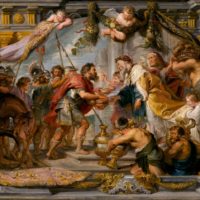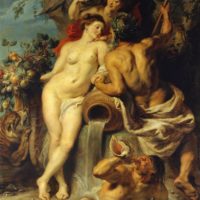| Painting Name | Massacre of the Innocents |
| Painter Name | Peter Paul Rubens |
| Completion Date | 1612 |
| Size | 142 × 182 cm (55.9 × 71.7 in) |
| Technique | Oil |
| Material | Panel |
| Current Location | Art Gallery of Ontario |
Peter Paul Rubens, the 17th century Flemish Baroque painter painted the first version of the biblical subject Massacre of the Innocents in 1612. It took him two years to finish the painting. It showcases the intense scene of King Herod’s (Herod the Great) soldiers killing the infants of Bethlehem during his reign.
Massacre of the Innocents
The subject of the painting is the intense massacre of the infants during the time of Herod the Great who after a prophecy, got furious that a Jew boy (Jesus) would uproot his grand reign. After getting outwitted by the Magi, and not knowing which baby would be the reason of his diminishing reign, in fury, he ordered to kill all the infants under age of two.
It was a hellish night for all the mothers of the town written with black letters on the pages of Christian history. One king’s wish to keep his throne safe and the desire to live longer, made thousands of infants dead and their mothers near to the death. This brutal massacre happened for one night. But, instead of the regular silence falling in streets every night, that night was the night of screams, clinging metal of swords and angry roars of the soldiers wielding babies in their hands by ankles, necks and broken wrists. That night, was more of like real hell descending on the face of earth for a little time. The goodness of the human heart was also killed by the king’s harsh order. When the rays of the sun flocked on the town next day, the streets were filled with puddles of blood and grotesque figures of infants. Near them were the mothers, who might have stared at their babies’ dead-bodies whole night or had died in front of them by the same tremor before the sun broke in East.
The chapter of the Massacre of the Innocents is written with swords dipped in the blood on the skin of the infants. Today, the dead infants are respectfully remembered as the Christian Martyrs.
Flemish Baroque
Peter Paul Rubens was prominently a Flemish Baroque artist. The style emphasized on movement, color and sensuality in paintings. The current portrayal is protruding the same characteristics of Flemish Baroque art. The painting represents a moment when the women are trying to save their children from the soldiers. The colors are bright and brilliant whereas the deliberately included nudity (which most likely didn’t happen in the real incident) showcases the sensual aspect of the Flemish Baroque art.
During the renaissance and later on in the Dutch Golden Age and the Flemish Baroque era, artists were intrigued to understand the real anatomy of a human body and based on their researches. The knowledge of human-anatomy in artistic community got refined over the years. Thus, the knowledge reflects in these prominent eras with masculine bodies of both men and women. Though, when the style faded in later times, artists started to depict more natural human bodies with realistic muscular bodies.
Apart from the Flemish Baroque style, the painting is said to have some elements of Chiaroscuro technique developed by the renaissance artist Caravaggio. A painting having Chiaroscuro, in a nutshell, is a painting having only one light source in it and the painter tries to explore only the most important areas of the subject with that light to eliminate the unnecessary distractions.
Thus, master painter Peter Paul Rubens has succeeded to represent the intensity of the real biblical event with oil on panel. One of the priceless pieces from the Baroque era. The work was sold in 2002 for around $82 million at Sotheby’s auction.





